Fourth generation
Nuclear power is deservedly considered one of the most conservative industries, which reached the top of the path on its S-curve. For the past 25 years, an external observer would not have noticed changes in key technology — all the same assemblies of fuel elements heating or boiling water, with the conversion of thermal energy into electrical energy. All the more surprising is the fact that nuclear energy sees its future in 6 revolutionary concepts, each of which in its own way shifts the paradigm of nuclear energy in one direction or another.

MRE salt melting research reactor housing, 70e
Also important is the fact that all these concepts did not arise today, but at the dawn of the nuclear industry and lost in the competition for the title of the industry standard for pressurized water reactors (PWR in Western terminology or BBER in the domestic). However, as in the case of electric vehicles, the gradual accumulation of the amount of technology can return to the pedestal the forgotten heroes of the dawn of the atomic age.
')
Fourth generation
From the beginning, the development of nuclear energy is usually divided into 3.5 unequal generations, where the first was noted by dozens of different concepts, sometimes quite strange today (for example, the British Magnox are graphite-moderated reactors and circulating compressed carbon dioxide as a coolant), the second is the two most severe accidents in the history of energy, and the third and third plus - the prevalence of financiers over engineers. To this day, the wonders and enthusiasm of the atomic age have been replaced by an epoch when the improvement in NPP performance by 2-3 percent is a revolutionary achievement widely discussed in the profile press.
The fourth generation should be a way beyond the deadlock in which the nuclear power industry finds itself. To do this, it will be necessary to solve several contradictory tasks at once - not to lose the safety of the reactor, improve or at least not worsen its economy and solve the problem of switching from using 235U to 238U .

6 concepts selected by the international organization Generation IV International Forum are trying to solve these problems from different angles. Which of them will become (and will become) the basis for the development of the nuclear industry in the 21st century should be shown by research over the next 15 years.
Sodium Fast Reactor
This type of reactor stands out sharply from the whole “team” with its sophistication and even some daily routine. A key feature of this reactor is the fast neutron spectrum, which allows the realization of a closed nuclear fuel cycle. However, these are not given for free, and the two biggest difficulties in such a reactor are fire-hazardous sodium and damage to the structures of the core by fast neutrons. However, in the 60s, at the moment of atomic energy generation, fast sodium was seen as the simplest on the way to closing the fuel cycle. And the CNFC, in turn, seemed necessary for the construction of thousands of reactors, for which there would simply not be enough reserves of 235 uranium isotopes.

The most "adult" and powerful representative of fast sodium reactors - BN-800.
As a result, BN-type reactors passed the longest way (20 ever built and functioning) from the first pilot plants to full-fledged power plants - Phenix and Superphenix in France, BN-600 in the USSR and BN-800 in Russia. At the beginning of the 80s, it seemed quite obvious that by 2020 hundreds and thousands of gigawatts of fast sodium reactors would be operating in the world. However, a sharp slowdown in the growth of atomic energy and various circumstances - such as the arrival of “green” power in France or the collapse of the USSR, cut off this take-off. In France, by the way, from 1995 to 1998, all elements of the CNFC were functioning — a plutonium fuel breeder, a plant for the reprocessing of SNF and a factory for the fabrication of fresh fuel ...

The device and characteristics of the French does not take off Super Phenix
Today, fast sodium reactors with an oxide or denser fuel from a mixture of U238 and Pu239 were frozen in step from starting to replace pressurized water reactors, and are fairly widely included (5-10 blocks in 10-15 year term and up to the basis of energy in the 30-50 year old) in the plans for the development of nuclear energy of four countries that really develop it - India, China, Russia and South Korea.

The reactor hall of the Indian sodium BR FBR
The key installations in this area today are the BN-600, BN-800 in Russia, MBIR planned here , and the PFBR pilot plants in India, ASTRID in France.
Fast lead reactor
Unlike the previous one, molten lead coolant reactors exist only on paper. This type was invented in an attempt to overcome the problems of BNov - sodium fire hazard (and associated technical complications - see details in the article about “BREST” ), sodium boiling in AZ in case of accidents and the associated danger of acceleration of the reactor on instantaneous neutrons . Another “emergency” plus of lead is the retention in the coolant of particularly unpleasant volatile fission products of uranium - iodine and cesium and shielding of nuclear fuel from gamma radiation.

BREST-OD-300 is the most advanced lead reactor project in the world today.
Of course, lead has its drawbacks. The most important is the high melting point (327 C), which means great concern for keeping the coolant in the molten state. The problems of lead corrosion of steel, poor compatibility with oxide (most common) fuel are also known, and in general it can be said that this type of reactor is little developed. Interestingly, on the basis of the idea of the evolution of sodium breeders in the USSR, a rather revolutionary BREST project was born, optimal for the slow development of atomic energy. In addition to lead, the key idea in it is to charge with fissile material once - at the start, and then recharge exclusively U238.

A collage of photos of the process of developing and testing the elements of BREST-OD-300. Such work takes thousands of years and costs billions of rubles.
Sometimes lead-bismuth reactors are added to a lead cohort. Adding bismuth to the coolant lowers its melting point to “sodium” values — about 100 C. Reactors with such coolant were serially placed on project submarines 705, but for all this proximity it is impossible to transfer one technology to another.
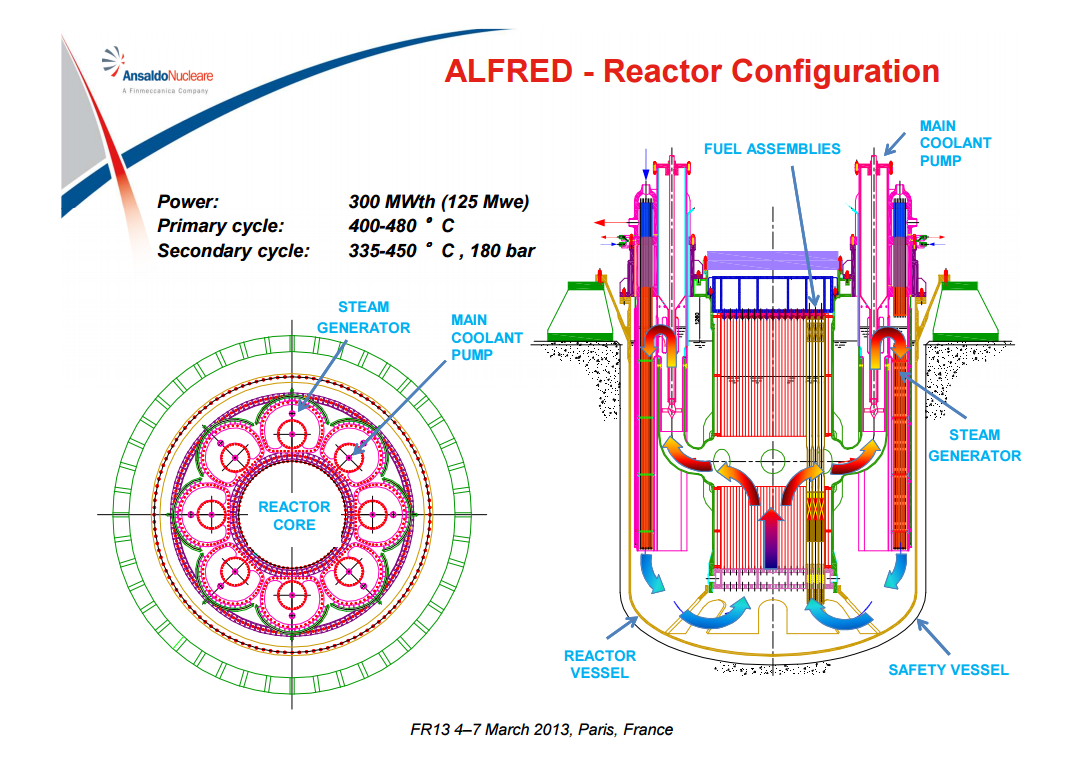
The lead-cooled ALFRED reactor is a smaller and simpler project for BREST, but also less technical risk.
BREST, along with the European ALFRED projects, are currently the only “living” lead projects that have funding and the likelihood of construction. In addition, there is a Belgian MYRRHA reactor with lead coolant, but this is an exotic and unique ADS system, where the neutron flux required for operation at power will be generated by an accelerating source. However, the real advantages and disadvantages of lead reactors compared to sodium are unlikely to be understood before 2030.
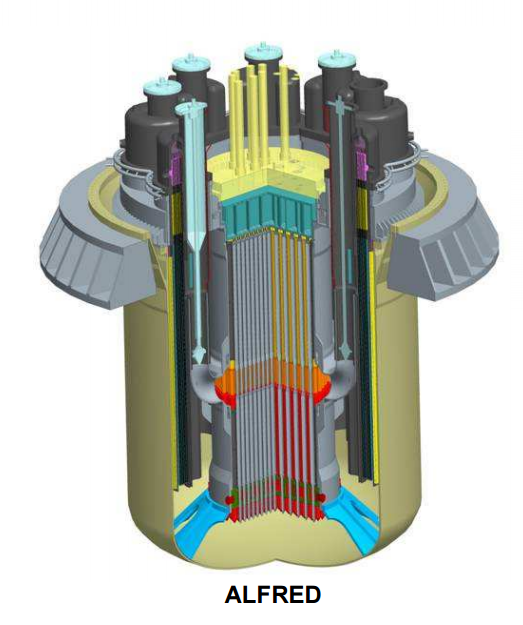
ALFRED is scheduled for construction in the 20s.
Gas cooled fast reactor
Reactors with a gaseous coolant of today is the Chinese development of the German HTR line. They have such a balanced set of pros and cons that the atomic industry does not see in them the development potential except for one, about which below. The gas reactors of the future should be different - fast neutron spectrum breeders (which, by the way, is very nontrivial for a helium active zone — a remarkable neutron moderator) cooled by inert helium and generating electricity on a gas turbine.
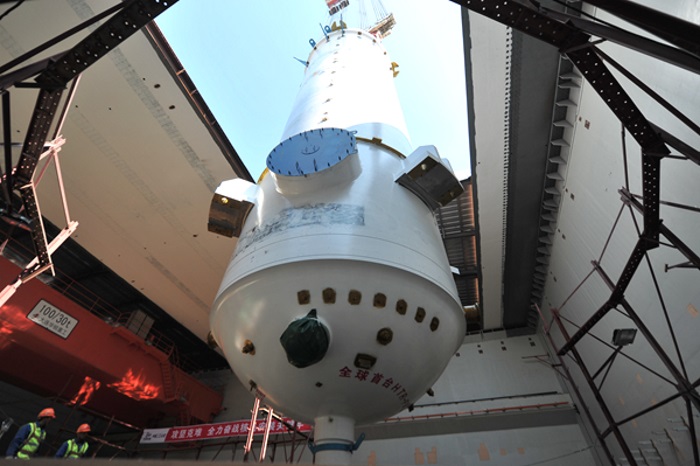
Installation of the hull of a new Chinese gas reactor 03/25/2016
Today, gas-cooled reactors have not received much development for a complex of reasons, the main of which is that there is nothing to cool the active zone during an LOCA-type accident (rupture of pipelines with loss of tightness by a reactor). In order to cope with this somehow, heat in the event of an accident is removed through the walls, and the size of the AZ inflates ten times compared with water-cooled reactors. In the IV generation, this problem will have to be solved, and if this can be done, the “gas fast” ones can start playing with completely new colors, with their very high efficiency.

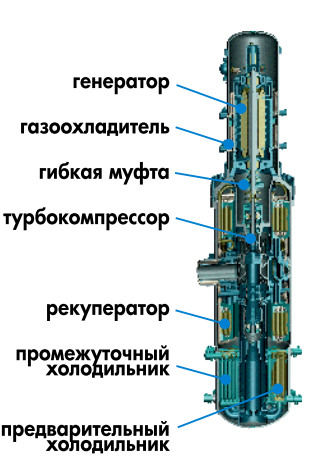

The design image of the GT-MGR with a gas turbine, the gas turbine generator itself and the characteristics of the reactor installation. No steam generators.
Such a single-circuit high-temperature approach, along with a completely different type of fuel (instead of a high-tech machine-building product that uses fuel in PWR / BWR / VVER), suggests something like modeling of millions of graphite bricks or balls with uranium particles inside) allows for very cheap atomic energy. So far, however, this is far away - just a breeder with a helium coolant and high temperature would get.
An important advantage of gas reactors is still the inertness and inactivability of helium used as a coolant. The downside is the significant energy cost of pumping helium through the core.

ALLEGRO gas cooled fast reactor
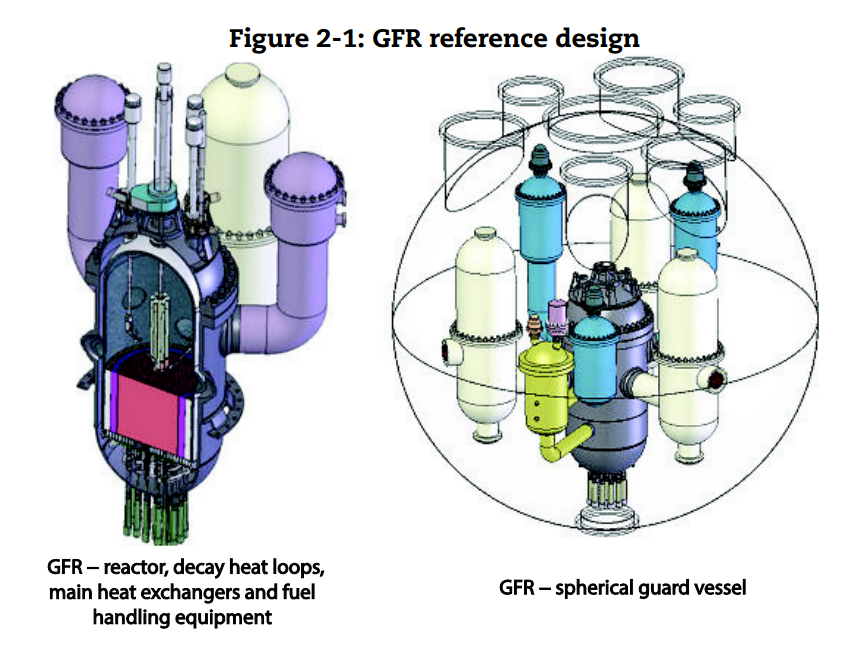
And a promising powerful gas cooled fast reactor GFR. It would be interesting to understand how they are going to cool the fuel when the reactor is opened ...
Today, the only active project in this area is the ALLEGRO European small research reactor, with a thermal capacity of 75 megawatts, using plutonium fuel. Its task is to study the questions facing the designers of a large (2,400 megawatt of heat) prospective European gas breeder GFR. One of the most difficult is the high temperature of fuel and helium. You can also note the domestic project GT-MGR , once developed as an alternative to the BN-800.
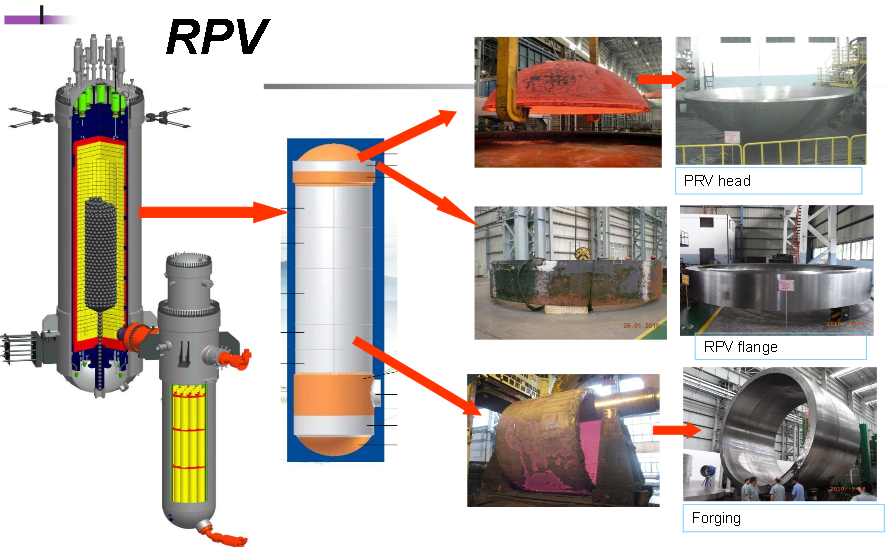
And a little bit of making Chinese HTR-PM. This time the steam generator is docked to the reactor vessel.
However, in terms of high temperature, competition for gas-cooled reactors consists of ... gas-cooled reactors that already exist today.
High temperature gas reactor
The younger brother of the concept number 3 whose main task is to be the source of nuclear heat for the chemical and metallurgical industries. To do this, helium exhaust from the reactor must be heated to 900 degrees Celsius or more. This direction was included into the promising list mainly due to a surge in interest in hydrogen energy in the 90s, when such plants had to produce hydrogen (a lot of hydrogen!) From water by the pyrochemical method.

Estimated station of hydrogen production using VGTR. Perhaps hydrogen will still be needed for the energy of the future, as an energy accumulator for systems with the dominance of renewable energy.
The main difference from the previous concept is that for the sake of high temperatures in the HTGR, they will refuse to fuel breezing and the CNFC. The technical basis for this type is the existing gas-cooled reactors with backfill ball (TRISO) or prismatic fuel. The Japanese research reactor HTTR , in particular, has already received a helium temperature of 850 C.
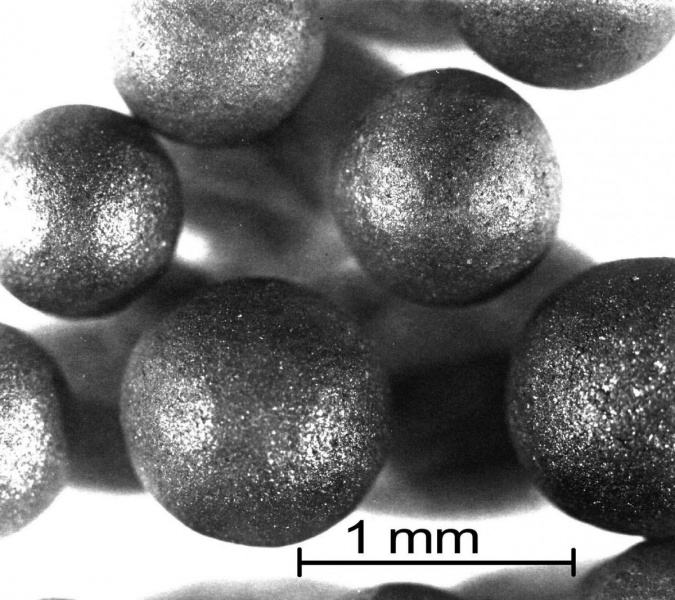
Uranium microspheres dispersed in graphite blocks - one of the options for fuel gas-cooled reactors
However, not very big difficulties (compared to other participants) with the implementation do not make the HTGR a favorite - along with the extinction of interest in hydrogen energy, the desire to invest in nuclear heat sources was also lost. Today, the only ones who are developing this area are the Chinese, who are building the first experimental industrial block HTR-PM and who have big plans for the development of this direction. However, it is possible that when coal becomes too expensive or inconvenient for industrial heat, we will still see the flourishing of the HTGR
Single-circuit supercritical water reactor
With a pressure above 225 atmospheres and temperatures above 374 degrees, the water stops boiling and turns into something between a liquid and a vapor. If we take and try to “overclock” the usual PWR / VVER to such parameters of the coolant, we can get many unusual advantages

Structurally, such reactors differ little from the usual VVER, all the subtleties in the design of fuel
Moreover, in thermal power engineering there is a great experience in creating steam power units on a supercritical pair, i.e. problems, as when creating a gigawatt gas turbine for gas cooled reactors will not arise. The vast experience of today's atomic energy in the development of PWR / VVER also plays into the hands.
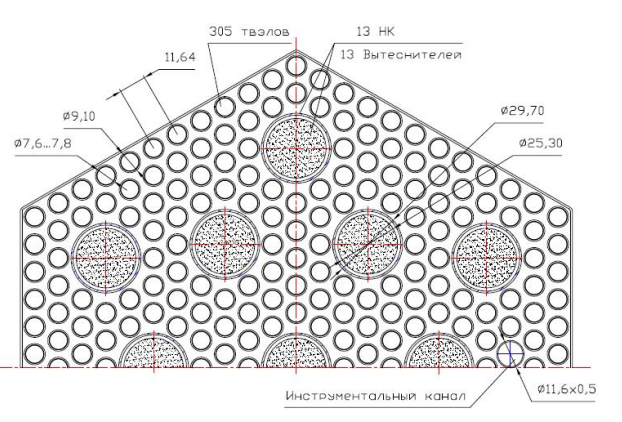

Fuel for such reactors has cavities and channels for moving elements that alter neutron moderation - spectral regulation of the reactor
The main obstacle to the implementation of this direction is the aggressiveness of steam at a pressure of 250 atmospheres and a temperature of 560 degrees (which are planned to be achieved in the ORSV projects), which means a large amount of new materials and structures. It is not easy and the creation of the reactor vessel for such parameters, despite the fact that the efficiency of 43% promise fast reactors with metal coolants.
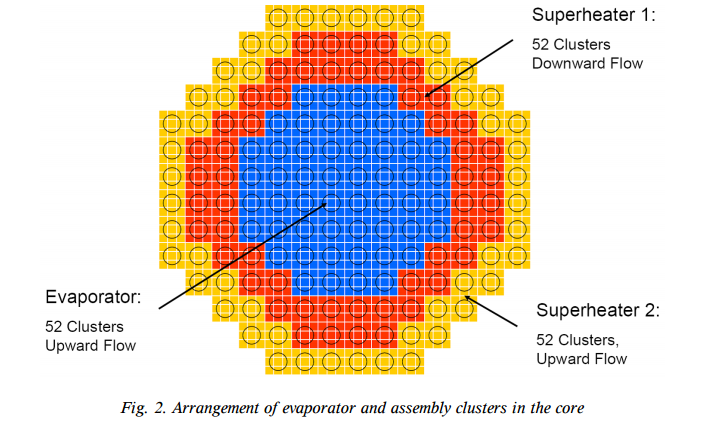
Americans also assume multiple passage of coolant through the core.
Today, the main research on the ORSV theme is going on in Russia and Japan and the United States, where VVER-SKD projects have been created (a large review article by reference) and the Japanese SCFR and RMWR and the American HPLWR are all completely paper-based.
Salt Reactor
The holy grail of nuclear energy, the place of worship for all reactor developers. Homogeneous molten mixture of beryllium / sodium fluoride and uranium / plutonium / thorium fluoride forms a liquid core, which is not terrible problem of radiation resistance. Continuous selection and purification of a part of the salt from decay products (including neutron poisons) allows maintaining the highest level of fuel reproduction and automatically forms a closed nuclear fuel cycle directly at the station. The reactor can be easily shut down, for example, by discharging the core into a trap, where it will not be critical. Moreover, the drain line can be plugged for a while with normal operation by the freezing plug of the fuel mixture, i.e. in case of loss of control, the stopping and localization of AZ will occur automatically. Heat in this type of reactor should be removed through heat exchangers located in the reactor vessel (integral type).
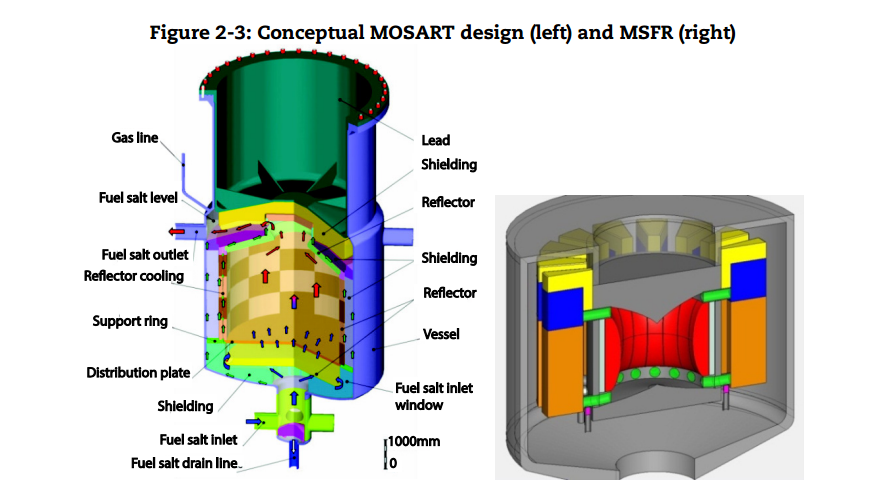
European projects CSR. Where other projects have the most complex core mechanics, ZhSR has a Buddhist emptiness.
In addition, GSR is the most convenient (along with heavy water) for involving thorium in the fuel cycle.

In addition to serious guys from Gen 4 IF, liquid salt reactors are proposed for use by various startups.
As usual, advantages are disadvantages at the same time. The absence of one of the barriers to the spread of radioactivity (shells of fuel rods) raises questions in atomic surveillance. The constant presence of literally the entire periodic table in the melt causes big problems with the corrosion resistance of the reactor vessel. The presence of a large radiochemical plant next to the reactor, besides radiophobic issues, also gives rise to problems with the non-proliferation of nuclear materials. After all, the CSR is a manufacturer of not just weapons-grade - but better than weapons-grade plutonium on a very tangible scale. In fact, at such a nuclear power plant it will be possible to produce weapons-grade material for dozens of nuclear bombs a year.

Another CSR from Transatomic Power startup. The frequency of accessing liquidators at startups is alarming.
In the 20th century, two small liquid salt reactors operated in the USA — the Aircraft Reactor Experiment (ARE) and the Molten Salt Reactor Experiment (MSRE), and only the second of them was successful, and it is believed to have been closed in 1976 in favor of much more successful (and something simpler) sodium-cooled fast reactors. ( An interesting documentary in English about MSRE)
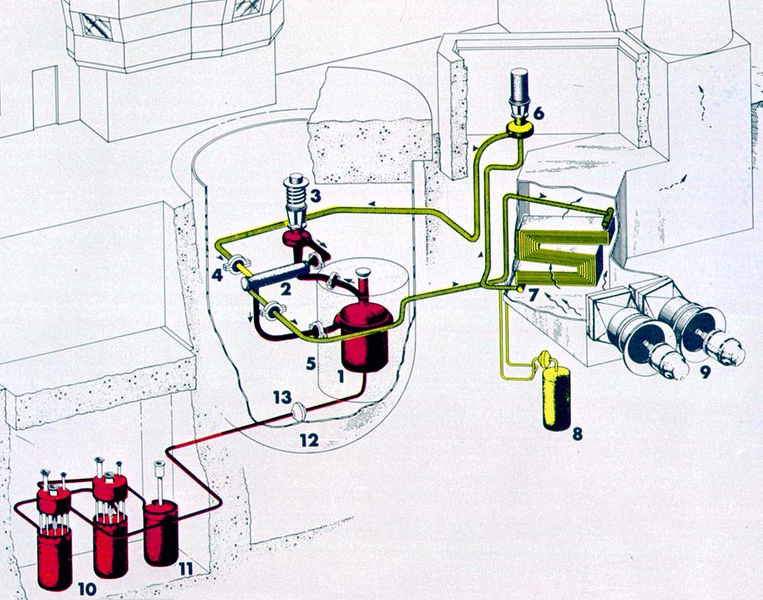
MSRE Reactor. Here 1 is a reactor, 2 is a heat exchanger of 1-2 circuits, 3.6 is a cycling pump, 7.8.9 is a system for removing heat from the reactor into the air, 10.11 is a molten salt drain tank, 13 is a frost plug for emergency draining salt.
Today, despite the regularly emerging interest in this “ideal nuclear reactor,” there is not a single project supported by financing a project to build at least a research facility. Only paper reactors are being developed, such as MOSART or MSFR or start-up projects. However, the potential promise makes it necessary to conduct a variety of supporting studies (for example, on corrosion resistance) in the hope that someday progress in other areas (for example, in materials) will give an impetus to the development of GSR.
Conclusion
If a stable interest in atomic energy arose in the world again, then the industry in zagashnik has developments capable of solving many problems of the sustainable provision of civilization with energy. However, in an environment where all the buns come from a renewable source, most likely in most of the promising reactor concepts we will only see pilot plants and their unhurried development.

MRE salt melting research reactor housing, 70e
Also important is the fact that all these concepts did not arise today, but at the dawn of the nuclear industry and lost in the competition for the title of the industry standard for pressurized water reactors (PWR in Western terminology or BBER in the domestic). However, as in the case of electric vehicles, the gradual accumulation of the amount of technology can return to the pedestal the forgotten heroes of the dawn of the atomic age.
')
Fourth generation
From the beginning, the development of nuclear energy is usually divided into 3.5 unequal generations, where the first was noted by dozens of different concepts, sometimes quite strange today (for example, the British Magnox are graphite-moderated reactors and circulating compressed carbon dioxide as a coolant), the second is the two most severe accidents in the history of energy, and the third and third plus - the prevalence of financiers over engineers. To this day, the wonders and enthusiasm of the atomic age have been replaced by an epoch when the improvement in NPP performance by 2-3 percent is a revolutionary achievement widely discussed in the profile press.
The fourth generation should be a way beyond the deadlock in which the nuclear power industry finds itself. To do this, it will be necessary to solve several contradictory tasks at once - not to lose the safety of the reactor, improve or at least not worsen its economy and solve the problem of switching from using 235U to 238U .

6 concepts selected by the international organization Generation IV International Forum are trying to solve these problems from different angles. Which of them will become (and will become) the basis for the development of the nuclear industry in the 21st century should be shown by research over the next 15 years.
Sodium Fast Reactor
This type of reactor stands out sharply from the whole “team” with its sophistication and even some daily routine. A key feature of this reactor is the fast neutron spectrum, which allows the realization of a closed nuclear fuel cycle. However, these are not given for free, and the two biggest difficulties in such a reactor are fire-hazardous sodium and damage to the structures of the core by fast neutrons. However, in the 60s, at the moment of atomic energy generation, fast sodium was seen as the simplest on the way to closing the fuel cycle. And the CNFC, in turn, seemed necessary for the construction of thousands of reactors, for which there would simply not be enough reserves of 235 uranium isotopes.

The most "adult" and powerful representative of fast sodium reactors - BN-800.
As a result, BN-type reactors passed the longest way (20 ever built and functioning) from the first pilot plants to full-fledged power plants - Phenix and Superphenix in France, BN-600 in the USSR and BN-800 in Russia. At the beginning of the 80s, it seemed quite obvious that by 2020 hundreds and thousands of gigawatts of fast sodium reactors would be operating in the world. However, a sharp slowdown in the growth of atomic energy and various circumstances - such as the arrival of “green” power in France or the collapse of the USSR, cut off this take-off. In France, by the way, from 1995 to 1998, all elements of the CNFC were functioning — a plutonium fuel breeder, a plant for the reprocessing of SNF and a factory for the fabrication of fresh fuel ...

The device and characteristics of the French does not take off Super Phenix
Today, fast sodium reactors with an oxide or denser fuel from a mixture of U238 and Pu239 were frozen in step from starting to replace pressurized water reactors, and are fairly widely included (5-10 blocks in 10-15 year term and up to the basis of energy in the 30-50 year old) in the plans for the development of nuclear energy of four countries that really develop it - India, China, Russia and South Korea.

The reactor hall of the Indian sodium BR FBR
The key installations in this area today are the BN-600, BN-800 in Russia, MBIR planned here , and the PFBR pilot plants in India, ASTRID in France.
Fast lead reactor
Unlike the previous one, molten lead coolant reactors exist only on paper. This type was invented in an attempt to overcome the problems of BNov - sodium fire hazard (and associated technical complications - see details in the article about “BREST” ), sodium boiling in AZ in case of accidents and the associated danger of acceleration of the reactor on instantaneous neutrons . Another “emergency” plus of lead is the retention in the coolant of particularly unpleasant volatile fission products of uranium - iodine and cesium and shielding of nuclear fuel from gamma radiation.

BREST-OD-300 is the most advanced lead reactor project in the world today.
Of course, lead has its drawbacks. The most important is the high melting point (327 C), which means great concern for keeping the coolant in the molten state. The problems of lead corrosion of steel, poor compatibility with oxide (most common) fuel are also known, and in general it can be said that this type of reactor is little developed. Interestingly, on the basis of the idea of the evolution of sodium breeders in the USSR, a rather revolutionary BREST project was born, optimal for the slow development of atomic energy. In addition to lead, the key idea in it is to charge with fissile material once - at the start, and then recharge exclusively U238.

A collage of photos of the process of developing and testing the elements of BREST-OD-300. Such work takes thousands of years and costs billions of rubles.
Sometimes lead-bismuth reactors are added to a lead cohort. Adding bismuth to the coolant lowers its melting point to “sodium” values — about 100 C. Reactors with such coolant were serially placed on project submarines 705, but for all this proximity it is impossible to transfer one technology to another.

The lead-cooled ALFRED reactor is a smaller and simpler project for BREST, but also less technical risk.
BREST, along with the European ALFRED projects, are currently the only “living” lead projects that have funding and the likelihood of construction. In addition, there is a Belgian MYRRHA reactor with lead coolant, but this is an exotic and unique ADS system, where the neutron flux required for operation at power will be generated by an accelerating source. However, the real advantages and disadvantages of lead reactors compared to sodium are unlikely to be understood before 2030.

ALFRED is scheduled for construction in the 20s.
Gas cooled fast reactor
Reactors with a gaseous coolant of today is the Chinese development of the German HTR line. They have such a balanced set of pros and cons that the atomic industry does not see in them the development potential except for one, about which below. The gas reactors of the future should be different - fast neutron spectrum breeders (which, by the way, is very nontrivial for a helium active zone — a remarkable neutron moderator) cooled by inert helium and generating electricity on a gas turbine.

Installation of the hull of a new Chinese gas reactor 03/25/2016
Today, gas-cooled reactors have not received much development for a complex of reasons, the main of which is that there is nothing to cool the active zone during an LOCA-type accident (rupture of pipelines with loss of tightness by a reactor). In order to cope with this somehow, heat in the event of an accident is removed through the walls, and the size of the AZ inflates ten times compared with water-cooled reactors. In the IV generation, this problem will have to be solved, and if this can be done, the “gas fast” ones can start playing with completely new colors, with their very high efficiency.



The design image of the GT-MGR with a gas turbine, the gas turbine generator itself and the characteristics of the reactor installation. No steam generators.
Such a single-circuit high-temperature approach, along with a completely different type of fuel (instead of a high-tech machine-building product that uses fuel in PWR / BWR / VVER), suggests something like modeling of millions of graphite bricks or balls with uranium particles inside) allows for very cheap atomic energy. So far, however, this is far away - just a breeder with a helium coolant and high temperature would get.
An important advantage of gas reactors is still the inertness and inactivability of helium used as a coolant. The downside is the significant energy cost of pumping helium through the core.

ALLEGRO gas cooled fast reactor

And a promising powerful gas cooled fast reactor GFR. It would be interesting to understand how they are going to cool the fuel when the reactor is opened ...
Today, the only active project in this area is the ALLEGRO European small research reactor, with a thermal capacity of 75 megawatts, using plutonium fuel. Its task is to study the questions facing the designers of a large (2,400 megawatt of heat) prospective European gas breeder GFR. One of the most difficult is the high temperature of fuel and helium. You can also note the domestic project GT-MGR , once developed as an alternative to the BN-800.

And a little bit of making Chinese HTR-PM. This time the steam generator is docked to the reactor vessel.
However, in terms of high temperature, competition for gas-cooled reactors consists of ... gas-cooled reactors that already exist today.
High temperature gas reactor
The younger brother of the concept number 3 whose main task is to be the source of nuclear heat for the chemical and metallurgical industries. To do this, helium exhaust from the reactor must be heated to 900 degrees Celsius or more. This direction was included into the promising list mainly due to a surge in interest in hydrogen energy in the 90s, when such plants had to produce hydrogen (a lot of hydrogen!) From water by the pyrochemical method.

Estimated station of hydrogen production using VGTR. Perhaps hydrogen will still be needed for the energy of the future, as an energy accumulator for systems with the dominance of renewable energy.
The main difference from the previous concept is that for the sake of high temperatures in the HTGR, they will refuse to fuel breezing and the CNFC. The technical basis for this type is the existing gas-cooled reactors with backfill ball (TRISO) or prismatic fuel. The Japanese research reactor HTTR , in particular, has already received a helium temperature of 850 C.

Uranium microspheres dispersed in graphite blocks - one of the options for fuel gas-cooled reactors
However, not very big difficulties (compared to other participants) with the implementation do not make the HTGR a favorite - along with the extinction of interest in hydrogen energy, the desire to invest in nuclear heat sources was also lost. Today, the only ones who are developing this area are the Chinese, who are building the first experimental industrial block HTR-PM and who have big plans for the development of this direction. However, it is possible that when coal becomes too expensive or inconvenient for industrial heat, we will still see the flourishing of the HTGR
Single-circuit supercritical water reactor
With a pressure above 225 atmospheres and temperatures above 374 degrees, the water stops boiling and turns into something between a liquid and a vapor. If we take and try to “overclock” the usual PWR / VVER to such parameters of the coolant, we can get many unusual advantages
- the most obvious is that the installation efficiency will increase from 33% to 42-43%
- power will rise 1.5 times at approximately the same size and cost of the reactor.
- less obvious - due to the high heat capacity of the resulting coolant, you can increase the ratio of the amount of uranium to water in the core and get a reactor with an intermediate neutron spectrum with a fuel reproduction factor in AZ of 0.8-1, i.e. almost close the nuclear fuel cycle.
- Due to the lack of boiling in AZ, it is much easier to make a single-loop reactor installation - as in the “boilers” of BWR, which further reduces the amount of equipment needed to produce a full-fledged nuclear power plant.

Structurally, such reactors differ little from the usual VVER, all the subtleties in the design of fuel
Moreover, in thermal power engineering there is a great experience in creating steam power units on a supercritical pair, i.e. problems, as when creating a gigawatt gas turbine for gas cooled reactors will not arise. The vast experience of today's atomic energy in the development of PWR / VVER also plays into the hands.


Fuel for such reactors has cavities and channels for moving elements that alter neutron moderation - spectral regulation of the reactor
The main obstacle to the implementation of this direction is the aggressiveness of steam at a pressure of 250 atmospheres and a temperature of 560 degrees (which are planned to be achieved in the ORSV projects), which means a large amount of new materials and structures. It is not easy and the creation of the reactor vessel for such parameters, despite the fact that the efficiency of 43% promise fast reactors with metal coolants.

Americans also assume multiple passage of coolant through the core.
Today, the main research on the ORSV theme is going on in Russia and Japan and the United States, where VVER-SKD projects have been created (a large review article by reference) and the Japanese SCFR and RMWR and the American HPLWR are all completely paper-based.
Salt Reactor
The holy grail of nuclear energy, the place of worship for all reactor developers. Homogeneous molten mixture of beryllium / sodium fluoride and uranium / plutonium / thorium fluoride forms a liquid core, which is not terrible problem of radiation resistance. Continuous selection and purification of a part of the salt from decay products (including neutron poisons) allows maintaining the highest level of fuel reproduction and automatically forms a closed nuclear fuel cycle directly at the station. The reactor can be easily shut down, for example, by discharging the core into a trap, where it will not be critical. Moreover, the drain line can be plugged for a while with normal operation by the freezing plug of the fuel mixture, i.e. in case of loss of control, the stopping and localization of AZ will occur automatically. Heat in this type of reactor should be removed through heat exchangers located in the reactor vessel (integral type).

European projects CSR. Where other projects have the most complex core mechanics, ZhSR has a Buddhist emptiness.
In addition, GSR is the most convenient (along with heavy water) for involving thorium in the fuel cycle.

In addition to serious guys from Gen 4 IF, liquid salt reactors are proposed for use by various startups.
As usual, advantages are disadvantages at the same time. The absence of one of the barriers to the spread of radioactivity (shells of fuel rods) raises questions in atomic surveillance. The constant presence of literally the entire periodic table in the melt causes big problems with the corrosion resistance of the reactor vessel. The presence of a large radiochemical plant next to the reactor, besides radiophobic issues, also gives rise to problems with the non-proliferation of nuclear materials. After all, the CSR is a manufacturer of not just weapons-grade - but better than weapons-grade plutonium on a very tangible scale. In fact, at such a nuclear power plant it will be possible to produce weapons-grade material for dozens of nuclear bombs a year.

Another CSR from Transatomic Power startup. The frequency of accessing liquidators at startups is alarming.
In the 20th century, two small liquid salt reactors operated in the USA — the Aircraft Reactor Experiment (ARE) and the Molten Salt Reactor Experiment (MSRE), and only the second of them was successful, and it is believed to have been closed in 1976 in favor of much more successful (and something simpler) sodium-cooled fast reactors. ( An interesting documentary in English about MSRE)

MSRE Reactor. Here 1 is a reactor, 2 is a heat exchanger of 1-2 circuits, 3.6 is a cycling pump, 7.8.9 is a system for removing heat from the reactor into the air, 10.11 is a molten salt drain tank, 13 is a frost plug for emergency draining salt.
Today, despite the regularly emerging interest in this “ideal nuclear reactor,” there is not a single project supported by financing a project to build at least a research facility. Only paper reactors are being developed, such as MOSART or MSFR or start-up projects. However, the potential promise makes it necessary to conduct a variety of supporting studies (for example, on corrosion resistance) in the hope that someday progress in other areas (for example, in materials) will give an impetus to the development of GSR.
Conclusion
If a stable interest in atomic energy arose in the world again, then the industry in zagashnik has developments capable of solving many problems of the sustainable provision of civilization with energy. However, in an environment where all the buns come from a renewable source, most likely in most of the promising reactor concepts we will only see pilot plants and their unhurried development.
Source: https://habr.com/ru/post/368653/
All Articles